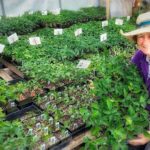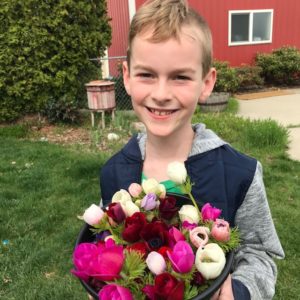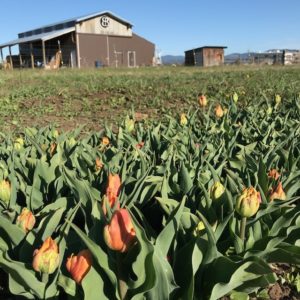| COVID-19 Information: Saturday Market will be open to 200 customers at a time to adhere to social distancing guidelines. Enter from South side of market. New Curbside Pickup option on Saturday. Wednesday market opening delayed until June. |
 Greetings, Market customers! We’re excited to be opening this weekend for our 2020 season! The world looks a bit different right now and, necessarily, so will our market. But we will still be here to supply you with healthy, local produce and plant starts, artisan foods, handmade gifts… and heartfelt smiles.
Greetings, Market customers! We’re excited to be opening this weekend for our 2020 season! The world looks a bit different right now and, necessarily, so will our market. But we will still be here to supply you with healthy, local produce and plant starts, artisan foods, handmade gifts… and heartfelt smiles.
COVID-19 Changes:
To adhere to social distancing guidelines, only 200 people will be allowed in the market at a time and vendors will be rearranging their booth spaces to facilitate adequate distancing
Masks are encouraged
Hand sanitizer will be available at every booth and extra handwashing stations placed throughout market
Food court and stage seating has been removed to discourage gatherings
NEW online ordering with Curbside Pickup option (see below)
For a complete list of market modifications due to COVID-19, click HERE.
| Fresh this Week: Hardy, local plant starts! Lettuce, bok choi, kale, swiss chard, radishes, green onions, salad mixes, fresh flowers, Mother’s Day bouquets. |
NEW! Curbside Pickup OptionOrder online for Saturday Curbside Pickup! This is a new, volunteer-run program during the pandemic to support both farmers and market customers during this challenging time. How it works:
Lettuce help you stay healthy! |
 Tips and Trick for New Gardeners
Tips and Trick for New Gardeners
…with Susi Faville, the Idaho Tomato Lady
If you are trying your hand at starting a garden for the first time this year (or the first time in a while), you are not alone. One of the more hopeful side-effects of the pandemic is a renewed interest in food production. And while experienced gardeners make it look easy, there are some important tips and tricks to maximizing the happiness of your garden.
Susi shares her top 8 here:
- Don’t plant too early. The rule of thumb in North Idaho is May 15th for tomatoes and peppers – or whenever the snow is off Mica Peak. That’s the peak to the south of I90 with the towers on it (one of them anyway). This rule applies if you are starting with transplants. For cucumbers and basil transplants, you want to wait until June 1st, or when the nights are no longer dipping below 45 degrees. “Work with the weather,” Susi says. “If you fight it you end up with bugs, sick plants, and plants that are producing too early, resulting in smaller fruit”.
- Buy local. Yes, Home Depot and Walmart have plant starts, but local farmers grow plants that are adapted to perform best in our climate and have been proven over many years. They are timed to be seasonally-appropriate and so that they produce in the peak time for each particular variety, and prior to typical frost in our area. They’re also hardened-off, which means they won’t wilt or die when transplanted outside.
- Varieties matter. The difference between a short-season pumpkin and a long-season pumpkin will mean the difference between a ripe or unripe pumpkin when the first frost comes. Again, buying from local farmers takes out the worry and guesswork.
- Get your soil ready. In her own words: Healthy soil is full of life, not just nutrients but fungi, bacteria and all sorts of micro organisms that are part of the natural system. The happier the soil biome is, the happier your plants are. Chemicals like Miracle Grow are perfect for hanging baskets and containers, but really don’t belong in the soil. On my farm I use fish meal, bone meal and sometimes kelp, along with compost and manure to feed the soil when I plant, and sometimes use fish emulsion mid season if needed, as my soil is basically sand. You can use boxed organic fertilizer blends that are now widely available at big box stores, Fred Meyer, North 40 and Cenex. If they say “organic”, then they are based on natural ingredients. Tomato food is nice, because of added calcium, but all-purpose ones with a high middle number (phosphorous) are good for veggies and flowers that are grown for their flowers or fruit. Leaf crops like lettuce prefer more nitrogen. You can add extra Blood Meal or Fish Meal to soil for leaf crops. Manure, compost and worm castings are also wonderful additions. Trace minerals “hitch hike” with the other fertilizers, but compost and green manures are also good sources. A lot of people say “I use compost, isn’t that enough?” I think we need more in the soil, especially after years of heavy cropping. Compost is a terrific way to introduce humus and microorganisms into your soil, but not all compost contains sufficient nitrogen and phosphorous.
- Be observant. Pay attention to your plants, how they’re reacting and what their needs might be. The plants will tell you what you need, if you just take time to notice. Learning to “notice” is a skill that will reap fruit.
- Avoid exotics. They sound exciting, but really they’ll probably just cause frustration.
- Find a good, local resources. Susi recommends following Spokane gardener Susan Molvahill on Facebook for timely, accurate local gardening info. She also recommends joining your local garden club.
- Finally, don’t forget to pay attention to the weather.

We’ll bloom again, Idaho! Photos courtesy of Winifred Flower Farm in Post Falls.



Leave a Reply